Lucky Catch Cruises gives guests a chance to experience life working on a Maine lobster boat during the 90 minute tour, including hauling real traps from Casco Bay while Captain Tom Martin teaches conservation practices that have sustained Maine's fishery for generations. You'll suit up in rubber aprons, measure lobsters with commercial gauges, and learn why escape vents and V-notching keep this industry thriving while other fisheries have collapsed. This working lobster boat departs from Long Wharf - a 15-minute harbor walk from cruise terminals - and delivers an authentic Maine lobstering experience culminating in a chance to enjoy fresh caught lobsters right on the pier at Portland Lobster Company!
What Do You Call Your "Guys Trips"?
- Real working lobster boat - not a tourist show but an actual commercial vessel that pulls genuine traps with Captain Tom Martin
- Hands-on participation - suit up to bait traps, measure lobsters, band claws, and push traps back into the water
- Conservation education - learn about V-notching, escape vents, size limits, and why Maine's lobster fishery thrives through sustainable practices
- Rare wildlife encounters - witness egg-bearing females, regenerating claws, and marine life that most people never see outside a lobster boat
- Perfect cruise excursion timing - 80-90 minute tours fit easily into Portland port stops with immediate access to Portland Lobster Company
- Small group experience - limited to around 20 passengers ensuring everyone gets personal attention and actual trap-hauling time
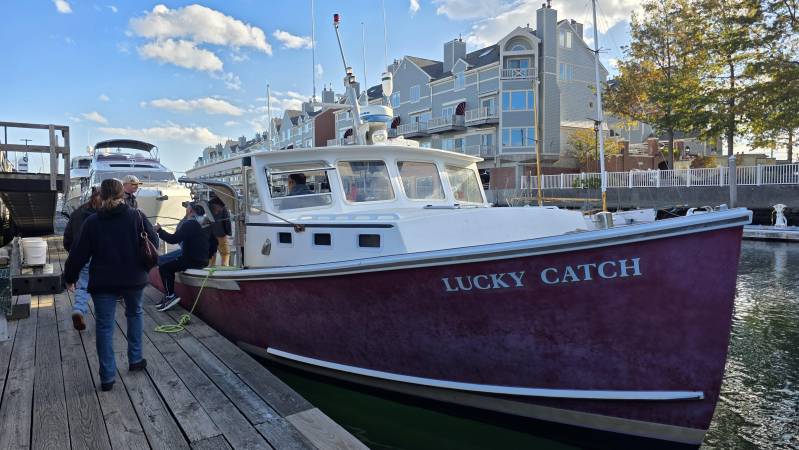
Most cruise excursions keep you at arm's length from the real experience - you watch, you listen, maybe you take photos. Lucky Catch throws that script overboard. This isn't dinner theater on the water where actors pretend to be fishermen. The experience combines everything that makes Maine guys trips memorable: authentic cultural immersion, hands-on adventure, spectacular coastal scenery alongside historic lighthouses and Civil War fortifications, and a chance to ask questionis and gain insider knowledge you can't get from YouTube or guidebooks.
I went to high school in a lobster town on the south shore of Boston and despite having friends whose dads and grandfathers were lobstermen, for some reason I never actually set foot on a lobster boat the entire time I lived in Cohasset. Heck, our school mascot was the Skipper, and we ate lobster all the time ... even got them fresh from the boats when they came into the harbor. So when looking at excursion ideas for our stop in Portland, Maine during our guys trip cruise to Canada and New England cruise on Norwegian Getaway, I jumped at the opportunity to go out with Lucky Catch Cruises.
For those of you who have done Alaska cruises I'm sure you've seen the Deadliest Catch crab boat experience in Ketchikan, Alaska - certainly it is entertaining as a show, but Lucky Catch offers something fundamentally different. Instead of a theatrical presentation designed primarily for entertainment, Captain Tom Martin is operating a real lobster boat and giving guests a chance to pull up actual lobster pots while sharing his trade in a fully interactive, authentic experience.
Captain Tom founded the company in 1996 after years of commercial lobstering, and these boats still work commercially during the off-season.
What I loved about this lobster boat experience is that it gives guests an opportunity to truly experience the process of catching lobster (and we pulled up a few other sea creatures, such as crabs, too). During the process, the Lucky Catch crew shares insights about conservation and what life is like as a lobsterman.
At one point, while discussing the way traps are designed to let immature lobsters escape after taking some bites of the bait, Captain Tom even joked that this teaches them to be attracted to the traps until one day, when they are too big to escape, that's when we get lucky and can catch them.
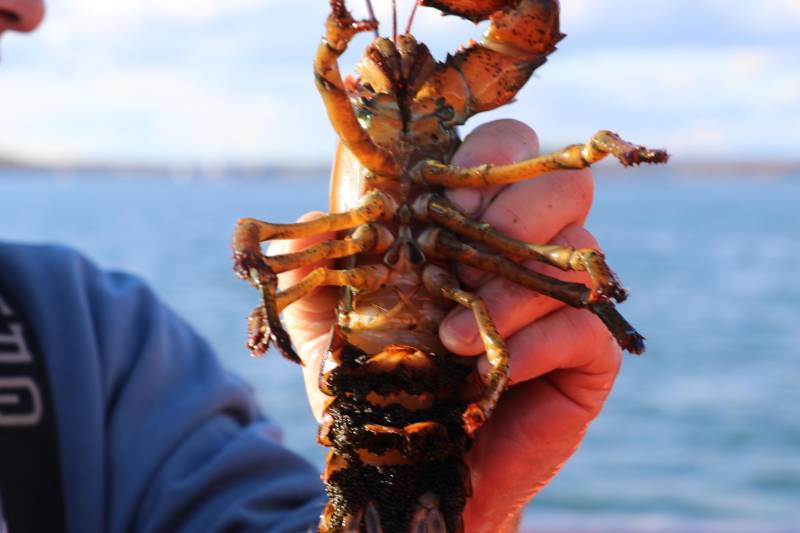
On our particular cruise, we caught a female that was full of eggs. This was a special experience since I'd never seen this before and it's pretty rare that anyone outside of a lobster boat crew would either since you need to immediately return her to the water to help preserve the chance of growing more lobsters.
During the tour, all guests get an opportunity to take part in the process - from suiting up with rubber aprons and gloves to load the bait bags to measuring the lobsters to even pushing the trap back in the water. This is truly an immersive experience that makes you really appreciate what goes into bringing these creatures to your plate.

Conservation Secrets That Keep Maine's Lobster Industry Going Strong
One of the most fascinating aspects of the Lucky Catch experience is the conservation education you receive. During our tour, the crew shared insights about several conservation practices that have kept Maine's lobster industry sustainable for generations.
Lobsters Can Regenerate Lost Claws
During our cruise, I learned that lobsters possess an remarkable ability to regrow lost claws, legs, and antennae. When a lobster loses a claw - whether from fighting with other lobsters or escaping predators - it can regenerate the limb through successive molts. The process takes several months to a few years depending on the lobster's age and size, with younger lobsters regenerating faster. The crew explained that lobsters will sometimes even voluntarily drop their own claws (a process called autotomy) to escape danger, knowing they can grow them back. It's like having a built-in survival backup plan.
V-Notching Protects Breeding Females
The egg-bearing female we caught provided a perfect teaching moment about Maine's V-notch program. Maine lobstermen have been voluntarily marking egg-bearing females since 1917 - long before it became law in 1948. When they find a female carrying eggs, they cut a small V-shaped notch in her tail flipper before releasing her back into the water. This mark tells all other lobstermen that this lobster is a proven breeder and must be thrown back, even after her eggs are gone. Research has shown that Maine's V-notching tradition is one of the primary reasons the state's lobster industry has remained robust while southern New England's has struggled. Strict penalties protect these breeding females - possessing egg-bearing lobsters can result in fines ranging from $2,500 to $10,000.

Escape Vents Let Small Lobsters Go Free
The trap design itself is a conservation marvel. Maine law requires every lobster trap to have rectangular escape vents measuring 1¾ inches by 5¾ inches (the minimum required by Maine Title 12, §6433). These vents allow undersized lobsters (those with shells smaller than 3¼ inches) to swim freely in and out of the trap. The captain joked that the traps essentially train young lobsters to be attracted to the bait, letting them come in for free meals until they grow too large to escape - which is exactly when they reach legal harvesting size. This wasn't mandated by government regulation; Maine lobstermen designed these vents themselves as part of their commitment to sustainable fishing for future generations.
Size Limits Protect Young and Large Breeders
Maine lobstermen can only keep lobsters between 3¼ inches and 5 inches in carapace length (the body shell from behind the eyes to the beginning of the tail). Lobsters smaller than that haven't matured enough to breed. But here's what surprised me: oversized lobsters also must be thrown back because the biggest females produce the most eggs - sometimes hundreds of thousands at a time. This dual protection ensures both young lobsters can mature and older breeding females can continue producing the next generation.
Escape Panels Prevent Ghost Trapping
The crew also explained that every trap must have a "ghost panel" - an escape panel secured with biodegradable hog rings. If a trap is lost on the ocean floor, these hog rings break down over time, allowing the panel to open so any trapped lobsters can escape. This conservation measure prevents "ghost traps" from continuing to catch lobsters indefinitely. Even the details Maine lobstermen don't see every day reflect their commitment to the industry's future.
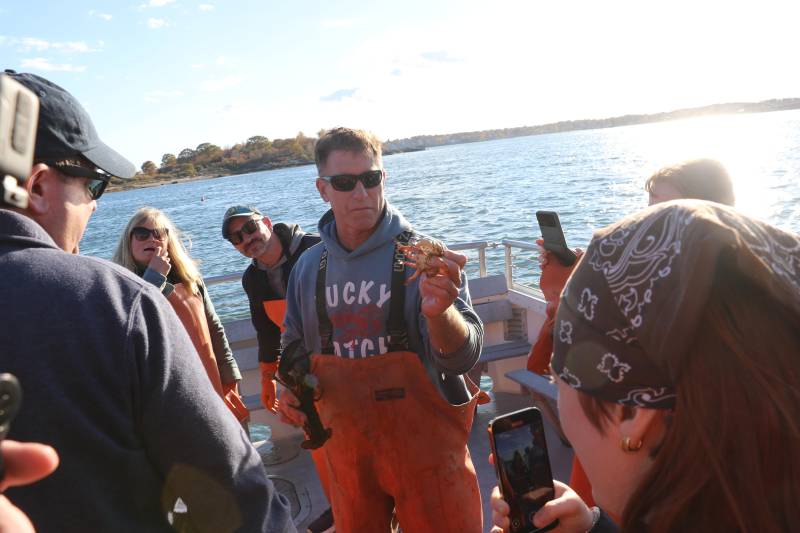
What to Know Before You Book Your Lucky Catch
Lucky Catch operates three boats with various itineraries throughout Casco Bay. Each 80-90 minute cruise pulls traps at different scenic locations depending on which tour you book. In October 2025, our tickets were approximately $50 per person. Some routes cruise past Portland Head Light (Maine's oldest lighthouse, commissioned by George Washington and first lit on January 10, 1791), Fort Gorges (a Civil War-era granite fortress), and Seal Rocks where harbor seals bask in the sun. Other itineraries explore different islands and lighthouses around Casco Bay. The scenery varies, but the authentic lobstering experience remains consistent across all tours - you're getting real trap-hauling regardless of which route you choose.
The logistics couldn't be easier for cruise passengers. Long Wharf, where Lucky Catch departs, is approximately half a mile from where cruise ships dock in Portland - an easy 15-minute walk along the harbor that lets you take in the waterfront atmosphere. The season runs from the first weekend of May through the last weekend of October (subject to weather and operational changes), perfectly aligned with cruise ship season in Portland. The company limits each boat to 20-22 passengers maximum depending on the vessel, ensuring everyone gets hands-on time with the traps and personal interaction with the crew.
Lucky Catch isn't typically offered as an official cruise ship excursion, so you'll need to book directly through their website or by phone. Keep in mind that many cruise ships use Portland as their first stop in the United States, which means you'll go through customs and immigration before being cleared to leave the ship. This process can take time, so don't book a tour that departs close to your ship's scheduled docking time - give yourself buffer room by selecting a later departure. If you have any doubts about timing or which tour to book, call or email Lucky Catch so they can help you make the right choice based on your ship's schedule.
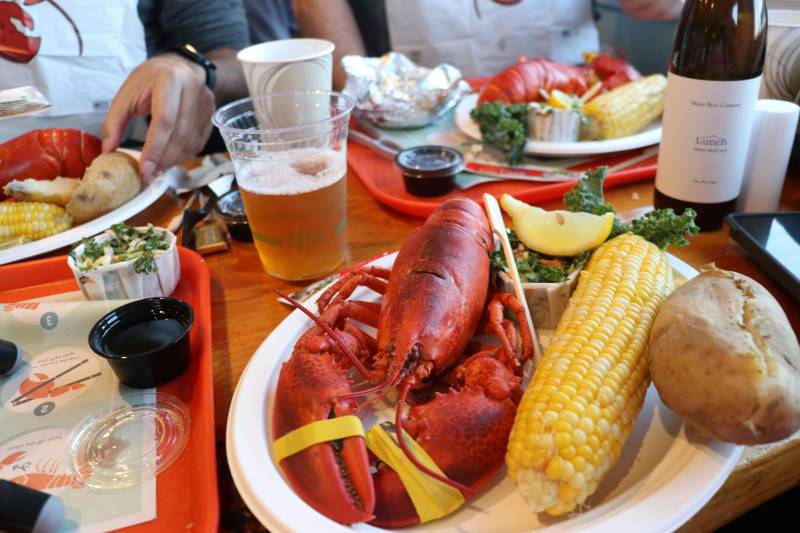
At the end of the cruise guests get an opportunity to purchase lobsters from the boat's tank ($10-$12.50) and take them to the Portland Lobster Company - right next to where the boat docks - to have them cooked for $12.95 (prices and availability subject to change). Due to commercial fishing regulations, guests purchase from the day's catch in the tank rather than keeping a specific individual lobster pulled from a particular trap, but you're still getting Maine lobster caught the same way you just experienced.
Considering other lobster restaurants in Portland will charge as much as $30-40 depending on season and location, this is a heck of a deal!
So, of course, Sujeet and I took advantage of this opportunity and went there after we docked and we were joined by another guy we met who was also on Norwegian Getaway with us. This ended up being an incredilbe experience - three guys enjoying "our catch" together surrounded by live music and a great selection of local craft beers ... you can't get much better than that to end an awesome day in Portland, Maine.
If you are worried about not wanting to get your hands dirty - don't worry, they are very accommodating for all levels of engagement. Initially I didn't want to get my hands dirty since I was focused on taking pictures and video but I couldn't resist after seeing how much fun others were having so I suited up and helped bait the trap, used the banding tool to put the rubber band on a lobster and even plunged my hand into the tank to pick out a lobster for dinner.
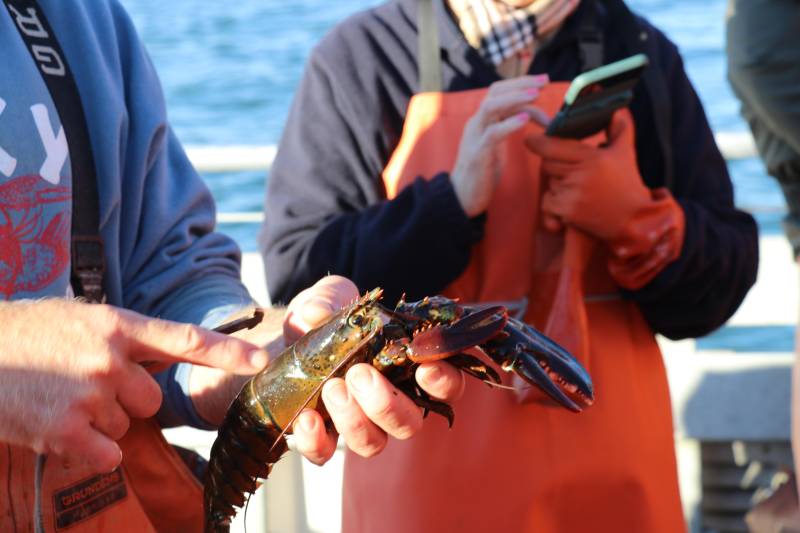
Lucky Catch Offers A Taste Of Maine Lobster Culture - The Perfect Excursion For Your Portland Guys Trip
This was honestly one of the best excursions that I've done on a cruise in a long while since it was so fun and immersive. A perfect way to experience the lobster culture of Maine on a guys trip cruise. Whether you're planning Maine guys trips or stopping in Portland as part of a New England cruise itinerary, Lucky Catch Cruises delivers an authentic experience that goes far beyond typical tourist activities. You're not just watching lobstering - you're doing it, learning why it works, and understanding why Maine produces the world's finest lobster through generations of conservation-minded practices. The combination of hands-on participation, spectacular Casco Bay scenery, genuine insights into a working fisherman's life, and the camaraderie of sharing this experience with your crew creates memories that outlast any typical shore excursion.
